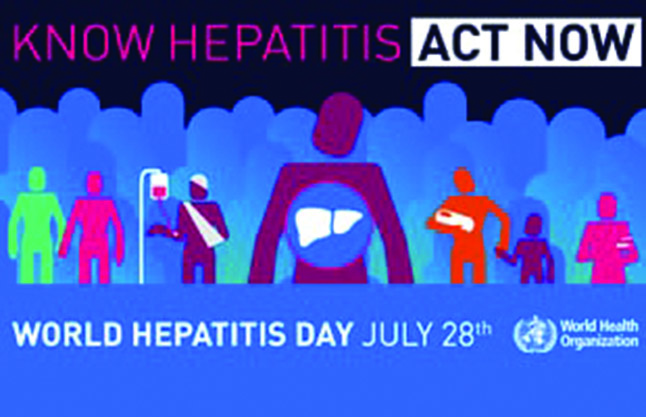
World Hepatitis Day is 28 July. I went to the website of the World Health Organization (WHO) to check out the event this year. Hepatitis remains a global challenge. World Hepatitis Day is observed each year on 28 July to raise awareness of viral hepatitis which causes inflammation of the liver that leads to severe disease and liver cancer. The theme for 2022 is “Bringing Hepatitis Closer To You”.
The world is currently facing a new outbreak of unexplained acute hepatitis infections affecting children. WHO, together with scientists and policymakers in affected countries, are working to understand the cause of this infection that does not appear to belong to any of the known five (5) types of hepatitis viruses: A, B, C, D, and E.
This new outbreak brings focus on thousands of acute viral hepatitis infections that occur among children, adolescents and adults every year. Most acute hepatitis infections cause mild disease and even go undetected. But in some cases, they can lead to complications and be fatal. In 2019 alone, an estimated 78 000 deaths occurred worldwide due to complications of acute hepatitis A to E infections.
Global efforts prioritize the elimination of the hepatitis infections B, C and D infections. Unlike acute viral hepatitis, these three (3) infections cause chronic hepatitis that lasts for several decades and culminate in over 1 million deaths per year from cirrhosis and liver cancer. These 3 types of chronic hepatitis infections are responsible for over 95% of hepatitis deaths. There are guidelines and tools to diagnose, treat, and prevent chronic viral hepatitis, but these services are often out of reach of communities and are sometimes only available at centralized/specialized hospitals.
On World Hepatitis Day 2022, WHO is highlighting the need for bringing hepatitis care closer to the primary health facilities and communities so that people have better access to treatment and care. WHO aims to achieve hepatitis elimination by 2030. The WHO is therefore calling on countries to achieve specific targets: reduce new infections of hepatitis B and C by 90%; reduce hepatitis related deaths from liver cirrhosis and cancer by 65%; ensure that at least 90% of people with hepatitis B and C virus are diagnosed; and at least 80% of those eligible receive appropriate treatment.
In May 2016, the World Health Assembly adopted the first Global health sector strategy on viral hepatitis, 2016–2021. The strategy highlighted the critical role of universal health coverage and sets targets that align with those of the Sustainable Development Goals. The strategy proposed the elimination of viral hepatitis as a public health threat by 2030 (defined as a 90% reduction in new chronic infections and a 65% reduction in mortality, compared with the 2015 baseline.
In May 2022 the 75th World Health Assembly noted a new set of integrated global health sector strategies on HIV, viral hepatitis and sexually transmitted infections for the period of 2022–2030. Based on these previous and now new strategies, a broad range of Member States have developed comprehensive national hepatitis programmes and elimination strategies guided by the global health sector strategy. According to the National Policy on viral hepatitis there is a high prevalence of chronic hepatitis B virus infection (≥ 8%) and hepatitis C virus infection (5-10%). There is a high burden of infection with resulting high prevalence of chronic liver disease, cirrhosis and liver cancer, a major cause of cancer death.
WHO is working on areas to support countries in moving towards achieving the global hepatitis goals under the Sustainable Development Agenda 2030: raising awareness, promoting partnerships and mobilizing resources; formulating evidence-based policy and data for action; increasing health equities within the hepatitis response; preventing transmission; scaling up screening, care and treatment services.
The WHO website has key facts on the viral hepatitis. On hepatitis A, itis an inflammation of the liver that can cause mild to severe illness. The hepatitis A virus (HAV) is transmitted through ingestion of contaminated food and water or through direct contact with an infectious person. Almost everyone recovers fully from hepatitis A with a lifelong immunity. However, a very small proportion of people infected with hepatitis A could die from fulminant hepatitis. The risk of hepatitis A infection is associated with a lack of safe water and poor sanitation and hygiene (such as contaminated and dirty hands). The hepatitis A virus is transmitted primarily by the faecal-oral route; that is when an uninfected person ingests food or water that has been contaminated with the faeces of an infected person. In families, this may happen though dirty hands when an infected person prepares food for family members. Improved sanitation, food safety and immunization are the most effective ways to combat hepatitis A. The spread of hepatitis A can be reduced by: adequate supplies of safe drinking water; proper disposal of sewage within communities; and personal hygiene practices such as regular handwashing before meals and after going to the bathroom. A safe and effective vaccine is available to prevent hepatitis A.
Hepatitis B is a viral infection that attacks the liver and can cause both acute and chronic disease. The virus is most commonly transmitted from mother to child during birth and delivery, as well as through contact with blood or other body fluids during sex with an infected partner, unsafe injections or exposures to sharp instruments. In highly endemic areas, hepatitis B is most commonly spread from mother to child at birth (perinatal transmission) or through horizontal transmission (exposure to infected blood), especially from an infected child to an uninfected child during the first 5 years of life. The development of chronic infection is common in infants infected from their mothers or before the age of 5 years. Sexual transmission is more prevalent in unvaccinated persons with multiple sexual partners. The hepatitis B virus can survive outside the body for at least 7 days. The incubation period of the hepatitis B virus ranges from 30 to 180 days. The virus may be detected within 30 to 60 days after infection and can persist and develop into chronic hepatitis B, especially when transmitted in infancy or childhood. WHO estimates that 296 million people were living with chronic hepatitis B infection in 2019, with 1.5 million new infections each year. The burden of hepatitis B infection is highest in the WHO Western Pacific Region and the WHO African Region, where 116 million and 81 million people, respectively, are chronically infected. In 2019, hepatitis B resulted in an estimated 820 000 deaths, mostly from cirrhosis and hepatocellular carcinoma (primary liver cancer). Hepatitis B can be prevented by vaccines that are safe, available and effective.
Hepatitis C is an inflammation of the liver caused by the hepatitis C virus. The virus can cause both acute and chronic hepatitis, ranging in severity from a mild illness to a serious, lifelong illness including liver cirrhosis and cancer. The hepatitis C virus is a bloodborne virus and most infections occur through exposure to blood from unsafe injection practices, unsafe health care, unscreened blood transfusions, injection drug use and sexual practices that lead to exposure to blood. Globally, an estimated 58 million people have chronic hepatitis C virus infection, with about 1.5 million new infections occurring per year. There are an estimated 3.2 million adolescents and children with chronic hepatitis C infection. WHO estimated that in 2019, approximately 290 000 people died from hepatitis C, mostly from cirrhosis and hepatocellular carcinoma (primary liver cancer). Antiviral medicines can cure more than 95% of persons with hepatitis C infection, but access to diagnosis and treatment is low. There is currently no effective vaccine against hepatitis C.
Hepatitis D virus (HDV) is a virus that requires hepatitis B virus (HBV) for its replication. Hepatitis D virus (HDV) affects globally nearly 5% of people who have a chronic infection with hepatitis B virus (HBV). HDV infection occurs when people become infected with both hepatitis B and D simultaneously (co-infection) or get hepatitis D after first being infected with hepatitis B (super-infection). In a study published in the Journal of Hepatology in 2020, conducted in collaboration with WHO, it was estimated that hepatitis D virus (HDV) affects nearly 5% of people globally who have a chronic infection with hepatitis B virus (HBV) and that HDV co-infection could explain about 1 in 5 cases of liver disease and liver cancer in people with HBV infection. The study has identified several geographical hotspots of high prevalence of HDV infection including Mongolia, the Republic of Moldova, and countries in western and central Africa. Populations that are more likely to have HBV and HDV co-infection include indigenous populations, recipients of haemodialysis and people who inject drugs. Worldwide, the number of HDV infections has decreased since the 1980s, due mainly to a successful global HBV vaccination programme. The combination of HDV and HBV infection is considered the most severe form of chronic viral hepatitis due to more rapid progression towards liver-related death and hepatocellular carcinoma. Hepatitis D infection can be prevented by hepatitis B immunization.
Hepatitis E is an inflammation of the liver caused by infection with the hepatitis E virus (HEV). Every year there are an estimated 20 million HEV infections worldwide, leading to an estimated 3.3 million symptomatic cases of hepatitis E. WHO estimates that hepatitis E caused approximately 44 000 deaths in 2015 (accounting for 3.3% of the mortality due to viral hepatitis). The virus is transmitted via the fecal-oral route, principally via contaminated water. Hepatitis E is found worldwide, but the disease is most common in East and South Asia. Prevention is the most effective approach against the infection. At the population level, transmission of HEV and hepatitis E infection can be reduced by maintaining quality standards for public water supplies and establishing proper disposal systems for human faeces. On an individual level, infection risk can be reduced by maintaining hygienic practices and avoiding consumption of water and ice of unknown purity.
Five types of viruses cause hepatitis, its attendant complications and chronic liver disease, most commonly hepatitis A virus (HAV), hepatitis B virus (HBV) and hepatitis C virus (HCV). Depending on the type, the viruses are transmitted by food, sex organs and blood, and may also cause co-infections. Vaccines against these viruses are not widespread. Treatment consists of administering immunomodulators (interferon) or nucleoside and nucleotide analogs, which can cause several side effects or result in drug resistance]. New antiviral strategies based on natural compounds are actively being pursued (Chojnacka et al. Antiviral Properties of Polyphenols from Plants. Foods 2021, 10, 2277. https://doi.org/10.3390/foods10102277).
Viral hepatitis infections trigger the production of reactive oxygen (ROS) and nitrogen(RNS) species. This is particularly true for infections caused by the blood-borne hepatitis viruses (B, C, and D), human immunodeficiency virus (HIV), influenza A, Epstein-Barr virus, respiratory syncytial virus, and other viruses. For acute respiratory viral infections, ROS/RNS have been implicated in lung tissue injury and epithelial barrier dysfunction which in turn increased the susceptibility to secondary infections. In case of chronic viral hepatitis, oxidative stress is known to promote liver fibrosis, cirrhosis, and cancer, as well as metabolic dysfunction.
Flavonoids, a subset of polyphenols use several mechanisms to inhibit and act on the viruses. They can obstruct the attachment and entrance of viruses into the cells, obstruct different phases of viral DNA replication, protein translation and poly-protein processing. They can also inhibit the viruses from being released to invade other healthy host cells. Flavonoids can attach to the surface proteins of viruses, prohibiting the virus from entering the host cells. Some flavonoids act as a transcription blocker and affect the replication process while others hinder the late stages of viral assembly, packaging and release. Flavonoids can also modulate the immune system and reduce viral load.
A nutrient-rich diet can lessen the possibility of chronic diseases and helps in making many viral infections less severe. There are functional foods laden with potent vitamins (vitamins A, D, C, E, B6, and B12), minerals (calcium and magnesium), trace elements (zinc, copper, selenium, etc.), carbohydrates, proteins, fats, and water. These multi-nutrients provide the highest nutritional value for all systems of the body, including bone, cardiovascular, liver, skin, and immune support. Therefore, eating a balanced diet rich in multi-nutrients can improve immunity against infections.
Cocoa is a notable functional food and a strong anti-oxidant. Cocoa constitutes a rich source of fiber (40-26%), lipids (24-10%), proteins (20-15%), carbohydrates (15%), and micronutrients (<2%) including minerals (P, Ca, K, Na, Mg, Zn, Cu) and vitamins (A, B, E). Cocoa also contains high amounts of methylxanthines (theobromine and small amounts of caffeine) and phenolic compounds named flavanols. Increasing cocoa consumption should be part and parcel of the collaborative efforts in reducing the burden of viral hepatitis in the country.
BY DR. EDWARD O. AMPORFUL
CHIEF PHARMACIST
COCOA CLINIC




